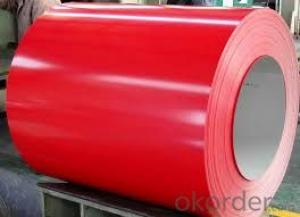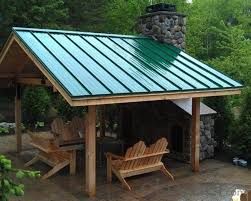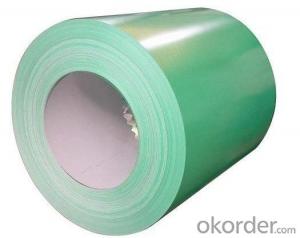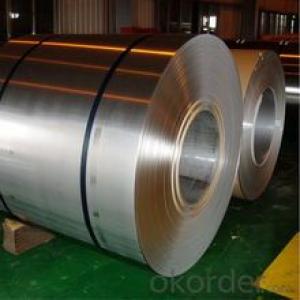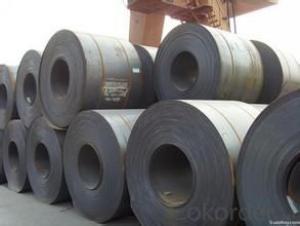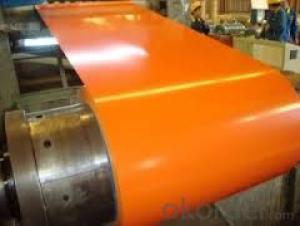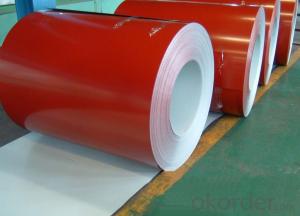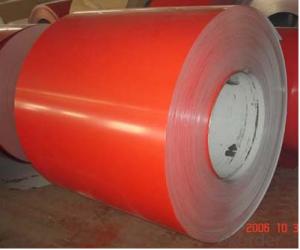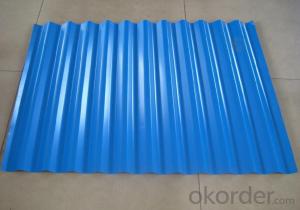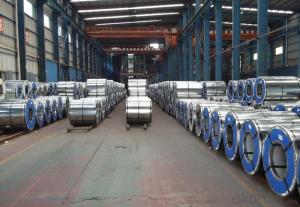Cold Rolled Galvanized Steel with Color Prepainted
- Loading Port:
- Shanghai
- Payment Terms:
- TT OR LC
- Min Order Qty:
- 20 m.t.
- Supply Capability:
- 9000 m.t./month
OKorder Service Pledge
OKorder Financial Service
You Might Also Like
Product Description
1. Prepainted cold rolled steel simple introduction:
Prepainted cold rolled steel is also named prepainted galvanized steel coil, which is produced by a new type of modern technology, which employs radiation hot-dipped galvanizing process mainly
Adopts the finishing hot galvanized steel as the raw material, then printing and baking
Some special colorful paint. Through this method, Prepainted cold rolled steel has the organic coating to
Protect itself from rusting, which would extend its service time as longer as 1.5 times
Than the usual galvanized steel coil.
2. Prepainted cold rolled steel special scope and products
1)Length: 762/900/914/1040/1215
2)Printed, Filmed, Pressed, Matte steel coil/sheet
2)G550 full hard
3. Prepainted cold rolled steel features:
-Corrosion resistance.
-Formability.
-Decoration.
- Excellent Workability.
4. Prepainted cold rolled steel applications fields:
Roofing and walling, curved profiles, corrugated sheets, foamed sandwich panels for roofing and walling, roof tills, rainwater gutter, metal doors, garage doors, wall panels for partitions, ceiling panels, suspended frames, interior metal doors or windows, profiles for exterior cabinets of white appliances, office furniture, home appliances, etc. Ppgi steel coil prepainted cold rolled steel coils
5. Prepainted cold rolled steel quality control:
Strict procurement process---skillful technical workers---final products inspection
(resistance to corrosion, salt spray test, exposure test, machinability, thermal resistance)
---standard packing
6. Prepainted cold rolled steel process:
Pay off reel-double cut shear-jonter-pre cleaning section-dryer-entry accumulation-cleaning section-chemical coater-chemical oven-primer coater-prime oven-prime coater cooling unit-dryer-finish coater-finish oven-finish coater cooling unit-dryer-tension leveler-exit accumulator-exit shear-tension reel
commodity | Prepainted cold rolled steel |
width | 600-1250mm |
thickness | 0.14-5mm |
standard | JIS G 3302-1998, ASTMA653M, GB/T 2518, Q/CHG3-2005, EN 10142, DX51D,ENG10142,SGCD(DX52D+Z) |
coil weight | 3-5 MT (Can be customized) |
technique | Hot dipped galvanized, alu-zinc coating, pre-painted, color coating, etc |
zinc coating | 60-275g/m2 |
tolerance | Thickness: +/-0.02mm Width: +/-2mm |
surface processing | Regular spangle, minimized spangle, zero spangle, bright spangle, etc |
application | Steel structure, building exterior application, building material, roofing household, application, tube making, etc^ |
product feature | Good performance, high precise, high straightness, high evenness and surface finishing, uniform thickness, easy for coating process, high tensile strength, high pressing property and low yield point |
package | Wrapped with waterproof paper inside, galvanized steel covered, tied by steel strip, supported by pallet, then loaded in container or according to customer' requirements |
delivery | Normally 10-20 days after get deposits or according to the quantity |
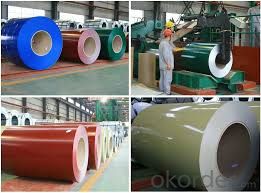
FAQ
1. Is the sample available?
Yes, samples can be sent for test if you need.
- Q: I felt that my nylon strings don't sound as good as steel ones. Is it okay that I replace them with steel ones, even if my guitar is classical? Thanks.
- I advise you not to as it will damage your guitar :) they do sound way better but that's what an acoustics for
- Q: What is the difference between black steel pipes and galvanized steel pipes when used for water or gas, and why?
- Just because two things are painted red doesn't mean that they're the same. You need to know what type of iron (if it really is iron, but doubtful) your black iron pipe is made from. Sometimes standard pipe used in commercial applications for plumbing is called black pipe by the contractors. This type of black pipe is usually A53. Pipes can come in many types of grades of steel. Is the pipe A500, A53, A106, etc? Each grade has slightly different chemical compositions that give the steel different mechanical characteristics. Also, pipe can come in different schedules (wall thicknesses) which does not change the outside diameter of the pipe. With an increase in wall thickness a pipe will become more rigid.
- Q: What are the typical lead times for ordering steel coils?
- The typical lead times for ordering steel coils can vary depending on several factors, including the supplier, the quantity and specifications of the coils, as well as the current market conditions. However, on average, lead times can range from a few weeks to a couple of months. It is always recommended to contact the specific supplier for more accurate information regarding lead times.
- Q: How are steel coils processed for cutting to length or blanking?
- Steel coils are processed for cutting to length or blanking through a series of steps. First, the coils are uncoiled and straightened to remove any bends or twists. Then, they are fed through a machine that measures and marks the desired length or shape. Next, a cutting tool or die is used to precisely cut the steel into the required dimensions. Finally, the cut pieces are inspected for quality and packaged for shipment.
- Q: I have a necklace that has a pendent made out of stainless steel. The pendent is connected by a cord, not chain, that I can take on and off; so, I leave it on all the time. It has gotten pretty tarnished because of that.
- When okorder okorder /
- Q: What are the common coil packaging materials?
- The common coil packaging materials include steel strapping, stretch film, polypropylene strapping, and HDPE (high-density polyethylene) sheets.
- Q: How are steel coils processed and shaped into different products?
- Steel coils are processed and shaped into different products through a series of manufacturing processes. The first step in the process is called uncoiling, which involves unwinding the steel coil and straightening it. This is usually done by feeding the coil through a machine called a decoiler. Once the coil is uncoiled, it goes through a process called leveling. This is done to eliminate any unevenness or warping in the steel. The coil is passed through a set of rollers that apply pressure and flatten the steel to the desired thickness. This ensures that the steel is uniform and ready for further processing. After leveling, the steel is typically cut into smaller pieces or sheets. This is done using machines such as shears or slitters, which can cut the steel into different widths or lengths. The precise dimensions will depend on the requirements of the specific product being manufactured. Once the steel is cut, it can undergo additional shaping processes. One common method is called roll forming, where the steel is passed through a series of rollers that gradually shape it into the desired profile. This is often used to produce products such as roofing sheets, wall panels, or beams. Another common shaping process is called stamping. In stamping, the steel is pressed between a die and a punch to create complex shapes or patterns. This is commonly used in the automotive industry to produce components such as car body panels or engine parts. In addition to shaping, the steel may also undergo surface treatments or coatings to enhance its properties or improve its appearance. This can include processes such as galvanizing, where a layer of zinc is applied to protect the steel from corrosion, or painting to provide a decorative finish. Overall, the process of shaping steel coils into different products involves a combination of cutting, shaping, and surface treatments. These processes are carefully executed to ensure that the steel meets the required specifications and is ready for use in various industries.
- Q: How are steel coils stored and transported?
- Steel coils are typically stored and transported in a horizontal position, either on the ground or on specially designed racks. They are often secured with steel straps or bands to prevent movement or damage during transportation. When being transported, steel coils are typically loaded onto flatbed trucks or shipping containers using cranes or forklifts. The coils are then secured in place with additional straps or chains to ensure stability during transit.
- Q: What are the common processing defects in steel coils?
- The common processing defects in steel coils include surface imperfections such as scratches, dents, and stains, as well as edge wave, coil set, camber, and crossbow. Other defects may include coil breaks, oil spots, rust, and uneven thickness or width variation.
- Q: How are steel coils used in the manufacturing of appliances?
- Steel coils are used in the manufacturing of appliances as a primary raw material for constructing the outer body and internal components, such as frames, panels, and structural supports. The steel coils are processed and transformed into various shapes and sizes, ensuring the durability and strength required for appliances.
Send your message to us
Cold Rolled Galvanized Steel with Color Prepainted
- Loading Port:
- Shanghai
- Payment Terms:
- TT OR LC
- Min Order Qty:
- 20 m.t.
- Supply Capability:
- 9000 m.t./month
OKorder Service Pledge
OKorder Financial Service
Similar products
Hot products
Hot Searches
Related keywords
